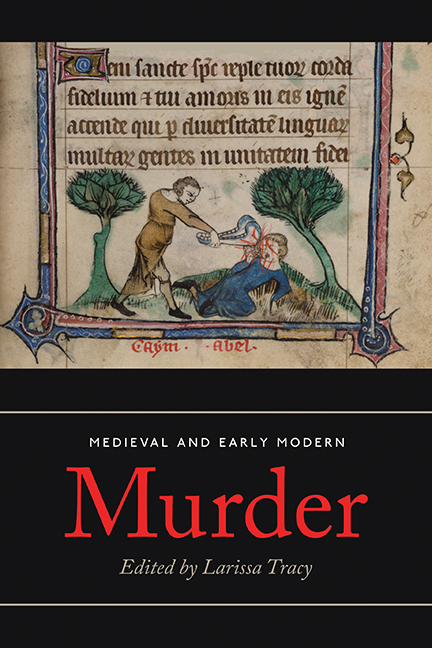Book contents
- Frontmatter
- Contents
- List of Illustrations and Tables
- Acknowledgements
- Contributors
- List of Abbreviations
- Introduction: Murder Most Foul
- I Murder on Trial: Justice, Law and Society
- II The Public Hermeneutics of Murder: Interpretation and Context
- III Murder in the Community: Gender, Youth And Family
- 13 Negotiating Murder in the Historiae of Gregory of Tours
- 14 Poisoning, Killing and Murder in the Edictus Rothari
- 15 Murder, Foul and Fair, in Shota Rustaveli's The Man in the Panther Skin
- 16 A Multiple Poisoning in the City of Valencia: Sanxo Calbó's Crime (1442)
- 17 A Case of Mariticide in Late Medieval France
- 18 Monstrous Un-Making: Maternal Infanticide and Female Agency in Early Modern England
- 19 Imps of Hell: Young People, Murder and the Early English Press
- Conclusion
- Select Bibliography
- Index
19 - Imps of Hell: Young People, Murder and the Early English Press
from III - Murder in the Community: Gender, Youth And Family
Published online by Cambridge University Press: 05 July 2018
- Frontmatter
- Contents
- List of Illustrations and Tables
- Acknowledgements
- Contributors
- List of Abbreviations
- Introduction: Murder Most Foul
- I Murder on Trial: Justice, Law and Society
- II The Public Hermeneutics of Murder: Interpretation and Context
- III Murder in the Community: Gender, Youth And Family
- 13 Negotiating Murder in the Historiae of Gregory of Tours
- 14 Poisoning, Killing and Murder in the Edictus Rothari
- 15 Murder, Foul and Fair, in Shota Rustaveli's The Man in the Panther Skin
- 16 A Multiple Poisoning in the City of Valencia: Sanxo Calbó's Crime (1442)
- 17 A Case of Mariticide in Late Medieval France
- 18 Monstrous Un-Making: Maternal Infanticide and Female Agency in Early Modern England
- 19 Imps of Hell: Young People, Murder and the Early English Press
- Conclusion
- Select Bibliography
- Index
Summary
ON 5 AUGUST 1664, Samuel Pepys paid a visit to William Joyce, husband to a cousin on his mother's side, and rode with him to Highgate. As the two men travelled together, their conversation turned to the subject of murder, in particular the death of Walter Clun, an actor who had been robbed, bound and left to die by a group of assailants earlier that week. Joyce proved especially fascinated by the crime, excitedly recounting ‘the manner of it … and manner of having it found out’, taking Pepys through the various scraps of information he had gleaned about Clun's final moments. Since the case had already made its way into the press by this point, appearing in the hastily written broadside An Egley on Mr Clun, much of his knowledge seems to have been culled from the printed news discourse that Pepys himself enthusiastically consumed. Ultimately, however, merely reading about the crime was not enough: Joyce also insisted on hunting out the exact spot where Clun had died, taking a detour to Kentish Town to find where he had ‘laid in a ditch, and … bled to death through his struggling’.
In many respects, the scene described by Pepys seems remarkably contemporary. Joyce's treatment of murder as entertainment, his delight in specific circumstantial detail and even his attraction to the site where Clun was killed is reminiscent of the ways in which murder has been marketed and consumed by news media and its audiences throughout the twentieth and twenty-first centuries. With his eager absorption of printed reports of violent crime, Joyce seems to differ little from the ‘readers of Sunday papers’ discussed by Orwell in his sardonic analysis of ‘the murders which have given the greatest amount of pleasure to the British public’. But the question is how seriously these similarities should be taken. It is true that the resemblance between early modern reading habits and later practices has often dominated scholarly discussion of early print culture. The growing body of criticism on Tudor and Stuart murder narratives has tended to stress the parallels between crime pamphlets and the popular journalism of more recent periods, at times using one to interpret the other.
- Type
- Chapter
- Information
- Medieval and Early Modern MurderLegal, Literary and Historical Contexts, pp. 434 - 455Publisher: Boydell & BrewerPrint publication year: 2018

